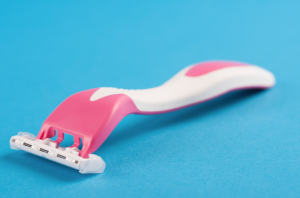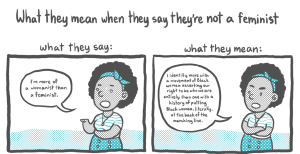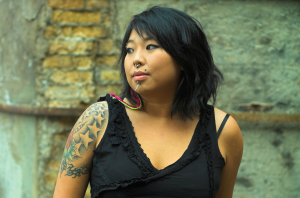Originally published on Role Reboot and republished here with their permission.
Every year, pubic hair is declared “back” – from the Daily Magazine in 2012, to the Telegraph in 2013, to Women’s Health Magazine in 2014, to Alternet in 2015.
But is it really?
How does pubic hair make a comeback every year?
Clearly, we desire pubic hair to be vogue. Now, bathing suit season is upon us. What do I do?
As a woman, I am very aware of my four options for downstairs: shave, wax, groom, or go au naturel.
When I started developing as an adolescent, I was surprised when things started to change. Having played with hairless Barbies for all my childhood, I guess I had been beguiled into believing pubic hair didn’t occur until you were much older. Regardless, I embraced the changes and journey of becoming a woman.
In my mid-teen years, I became aware that women were shaving and more “risqué” girls were starting to wax.
As my body developed and low-cut jeans, bikinis, and shorter shorts started to fill my closet, I, too, hopped on the bandwagon that believed hair was unfeminine, unsightly, and needed to be removed.
That is, until this year, when I decided to examine the wagon I was riding.
In a recent US study conducted among 2,000 sexually active women under the age of 30, 88% of the women ages 18-24 reported removing some to all of their pubic hair.
59% of the women reported their pubic hair status as typically or sometimes completely hair-free. In another study published this year, 49.8% of the women reported being typically hair-free.
Only 4.1% of women reported not trimming or removing any pubic hair, leaving 95% of the women with groomed, trimmed, or removed pubic hair.
Evidently, the overwhelming majority of women under 30 remove some to all of their pubic hair.
The next question on my mind was why?
In another study asking over 600 women what their motivations were for removing pubic hair, the most common reasons were “It looks better in a bathing suit,” “It makes me feel attractive,” “I feel more feminine and more comfortable,” and “I think it’s cleaner.”
Other common, though slightly less popular answers, included “partner likes it,” “men prefer it,” and other reasons related to sex.
Reading these reasons cited for hair removal sparked a desire to learn more.
Is pubic hair removal merely a Western generated phenomenon? Is hair removal filled with rich insight or is it merely a current stubbly blip in the historical lens of personal care?
Without sufficient written accounts, ancient Egypt drawings depict women with small triangles of pubic hair and bronze razors placed in their tomb for the afterlife. Women from ancient Greece and the Roman Empire also practiced body hair removal, as pubic hair was considered “uncivilized.”
Anthropologists have suggested that hair removal (including arms, face, and pubic region) was for a multitude of reasons including hygiene (e.g. to avoid pubic lice), aesthetics, fashion, class symbolism, and cultural symbolism.
Interestingly, though it may have been practiced in some Eastern and African cultures, removal of pubic hair was not traditionally found among European Caucasian women.
Furthermore, throughout the following several thousand years, pubic hair grooming was a woman’s decision and removal of it was not widely practiced throughout the Middle Ages, Renaissance, and Victorian era all the way until the late 1900s.
Beginning with the 20th century, as arms and legs became more exposed, Gillette introduced the first razor for women in July 1915 along with the message that body hair was “unsightly” and “objectionable” and thus needed to be removed.
Not incidentally, introducing hair removal to American women coincided with substantial changes in women’s clothing, especially for the upper class.
Hemlines shortened to reveal ankles, and sleeves on dresses retreated to show more bare arms. Yet, it wasn’t until the Ladies Home Journal publisher and marketer, Cyrus Curtis, delivered a speech to his advertisers that revealed his capitalist mentality:
“Do you know why we publish the Ladies’ Home Journal? The editor thinks it is for the benefit of American women. That is an illusion…the real reason, the publisher’s reason, is to give you people who manufacture things that American women want and buy a chance to tell them about your products.”
As literacy significantly grew, women’s magazines became a staple.
In addition to household products like soap, food, and clothing, magazines began to market self-improvement products such as facial creams, makeup, and hair removal remedies (referred to as “smoothening” since shaving was negatively associated with being masculine).
Until this time, hair removal (let alone pubic hair) was not widely practiced.
Fast-forward to the 1950s and Hugh Hefner’s introduction of Playboy magazine with its clean-shaven, scantily-clad models. The magazine, risqué for its time, revealed sexy, lingerie-draped women who became benchmarks for the ideal feminine beauty.
Shortly after, Western culture entered a dichotomous time period.
Although Playboy certainly nurtured an ideal of feminine beauty, the 1960s and 1970s was a time when feminists starkly opposed and rejected the culturally imposed ideal of hairless feminine beauty, preferring au naturel.
Women could feel socially supported to do with their hair removal as they pleased. However, this phenomenon proved to be short-lived as the hairless ideal gained momentum.
Aside from models or actors who engaged in more extreme pubic hair removal, the famous seven Brazilian J. Sisters can be thanked (or blamed) for setting up shop in Manhattan, New York and introducing the Brazilian wax to the American public in 1987.
Youngest J sister Jonice told the New York Observer, “Makes you sexy. Makes you fashion. When I don’t have a bikini wax, I don’t feel like to have sex with my husband. I feel dirty. And even himself say, ‘Try a bikini wax!’ I feel free. I feel clean.”
However, the Brazilian wax would remain a less common option until almost 13 years later in 2000 when an iconic episode of Sex and City aired and Carrie Bradshaw got a Brazilian.
Now, in the past 20 years with influence of Internet pornography, the porn industry has solidified the image of a hairless woman as the beauty ideal.
Top selling magazines like Maxim, Playboy,and GQ display pornified women that infiltrate our culture while Jenna Jameson has become a household name with her New York Times bestseller How To Make Love Like a Porn Star.
According to one study, approximately 30% of the Internet is taken up by pornography. Porn is a form of sex education in the Western world and the hairless, pre-pubescent look is the look in porn.
Today, hair removal is an ingrained habit, like eyebrow plucking or nail-cutting, but there are some deeper issues to explore.
What really is the bottom line of the hairless Brazilian wax or nearly hairless genitals? A socially constructed idea of sexiness that is ultimately driven by consumerism and marketing.
With regards to the Brazilian wax, powerful words are spoon-fed to us so that we associate the ripping of hot wax off our genitals as “sexy,” “empowering,” “fashionable,” “clean,” and “more comfortable.”
But is it really sexier and empowering? Or are those merely enticing words blended together to sound meaningful?
The waxing industry is certainly trying to convince us that shelling out $40-$80 every four weeks is necessary. Surveys show that women will spend approximately $10,000 and the equivalent of over four months of their lives removing hair.
Why?
Historically speaking, sex au naturel has worked for thousands of years, and it’s only in the last 50 years that things have substantially changed. If only Cyrus Curtis of Ladies Home Journal could see what trends he kickstarted. He would be so proud.
Most of us who have undergone waxing have had serious reservations about the painful process the first few (or ten) times we did it. Let’s be serious, waxing and hair removal is painful – and yet if women don’t do it, there seems to be a serious societal taboo and embarrassment.
As one author wrote, “For every Brazilian you get, another woman might feel more pressured to do so. Symbolically speaking, you’re not alone on that salon table, with your ankles up around your ears as you exhale with each rip of the wax strip. And that takes sisterhood to a whole new level.”
There might be something deeper that we are missing in terms of truly understanding what sexiness is. The obsession with removing pubic hair is perhaps a Band-Aid answer (get a bikini wax and you will feel sexy) to our superficially obsessed culture.
Feeling sexy does not come from having something done to you, but rather is a feeling of being comfortable with yourself. True sexiness is ultimately a lifelong process.
This is the bottom line: Your genitals are your own personal, private business and deciding to wax, shave, or go au naturel isn’t more feminine or attractive, it just is what it is. Words like “empowered,” “feminine,” or “sexy” describe who you are as a woman and a person, not the state of your pubic hair.
Your genitals are your own – and spending too much time or money on it isn’t going to help you become stronger, speak better, or think quicker.
[do_widget id=’text-101′]
A partner with RAW Beauty Talks, Renae Regehr is the founder of More to Her, a research driven organization that aims to educate and empower girls about the nuanced and limiting messages in media. Her research tends to focus on the representation of women in media and how it impacts the viewer’s attitudes and beliefs. She is completing a Masters of Counseling and occasionally writes about other things, such as parenthood and the impact of pornography.
Search our 3000+ articles!
Read our articles about:
Our online racial justice training
Used by hundreds of universities, non-profits, and businesses.
Click to learn more
Most Read Articles
- « Previous
- 1
- …
- 30
- 31
- 32




















